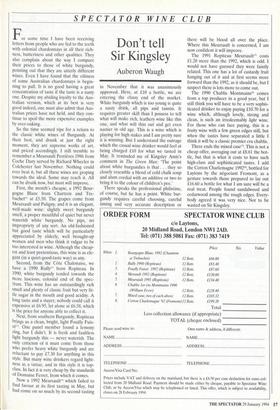SPECTATOR WINE CLUB
Don't tell Sir Kingsley
Auberon Waugh
For some time I have been receiving letters from people who are fed to the teeth with colonial chardonnays in all their rich- ness, butteriness and other qualities. They also complain about the way I compare their prices to those of white burgundy, pointing out that they are utterly different wines. Even I have found that the oiliness of some Australian chardonnays is begin- ning to pall. It is no good having a great concentration of taste if the taste is a nasty one. Despite my abiding loyalty to the Aus- tralian version, which at its best is very good indeed, one must also admit that Aus- tralian prices have not held, and they con- tinue to spoil the more expensive examples by over-oaking.
So the time seemed ripe for a return to the classic white wines of Burgundy. At their best, and drunk at just the right moment, they are supreme works of art, and priced accordingly. I still tremble to remember a Meursault Perrieres 1986 from Coche Dury served by Richard Wheeler in Colchester last November. Nothing could ever beat it, but all these wines are groping towards the ideal. Some may reach it. All can be drunk now, but most will improve.
First, the month's cheapie, a 1992 Bour- gogne Blanc from Chartron and Tre- buchet", at £5.50. The grapes come from Meursault and Puligny, and it is an elegant, well-made wine: slightly sweet burgundy smell, a proper mouthful of quiet but never waterish white burgundy. No pips, no impropriety of any sort. An old-fashioned but good taste which will be particularly appreciated by elderly, well brought-up women and men who think it vulgar to be too interested in wine. Although the cheap- est and least pretentious, this wine is as ele- gant (in a quiet-good-taste way) as any.
Second, from the Cote Chalonaise, we have a 1990 Rully'') from Ropiteau. In 1990, white burgundy tended towards the more luscious, colonial end of the spec- trum. This wine has an outstandingly rich smell and plenty of classic fruit but very lit- tle sugar in the mouth and good acidity. A long taste and a stayer; nobody could call it expensive at £6.95, let alone at £6.58, which is the price for anyone able to collect it. Next, from southern Burgundy, Ropiteau
brings us a clean, bright, light Pouilly Fuis- se°). One panel member found a lemony zing, but I. didn't. It is fresh and faultless
light burgundy this — never waterish. The only criticism of it must come from those who prefer heavy white burgundy and are reluctant to pay £7.30 for anything in this style. But many wine drinkers regard light- ness as a virtue, and in this style it is top- class. In fact it is very cheap by the standards of Domaine Ferret, from which it comes.
Now a 1992 Meursault(4) which failed to find favour at its first tasting in May, but had come on so much by its second tasting in November that it was unanimously approved. Here, at £10 a bottle, we are entering the classy end of the market. White burgundy which is too young is quite a nasty drink, all pips and tannin. It requires greater skill than I possess to tell what will make rich, leathery wine like this one, and what will thin out and get even nastier in old age. This is a wine which is playing for high stakes and I am pretty sure it is winning. But I understand the outrage which the casual wine drinker would feel at being charged £10 for what we tasted in May. It reminded me of Kingsley Amis's comment in The Green Man: 'The point about white burgundies is that . . . they so closely resemble a blend of cold chalk soup and alum cordial with an additive or two to bring it to the colour of children's pee.'
There speaks the professional philistine, of course, but he has a point. White bur- gundy requires careful choosing, careful timing and very accurate description or there will be blood all over the place. Where this Meursault is concerned, I am now confident it will improve.
The 1991 Ropiteau Meursault(s) costs £1.20 more than the 1992, which is odd. I would not have guessed they were faintly related. This one has a lot of custardy fruit hanging out of it and at first seems more forward than the 1992, as it should be, but I suspect there is lots more to come out.
The 1990 Chablis Montmains(8) comes from a top producer in a good year, but I still think you will have to be a very sophis- ticated drinker to enjoy paying £10.70 for a wine which, although lovely, strong and clean, is such an irredeemably light wine. For those who can face paying, this is a fruity wine with a few green edges still, but when the tastes have separated a little I think it will be a classic premier cru Chablis.
There ends the mixed case). This is not a cheap offer, averaging out at £8.61 the bot- tle, but that is what it costs to have such high-class and sophisticated tastes. I add the Corton Charlemagne 1992(8), bottled for Laytons by the negotiant Fromont, as a gesture towards those prepared to lay out £16.60 a bottle for what I am sure will be a real treat. People found sandalwood and cedarwood among the rough edges. Every- body agreed it was very nice. Not to be wasted on Sir Kingsley.


































































 Previous page
Previous page